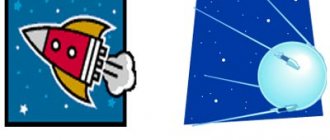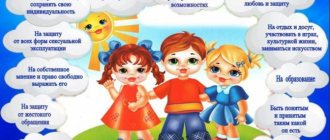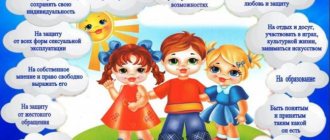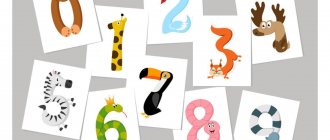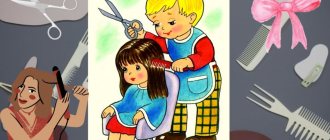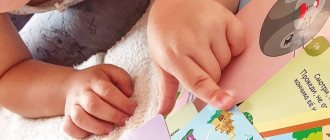Didactic game “Ask a friend a question”
The goal of the game is to teach preschoolers to communicate competently through questions and answers. The lesson can be in pairs or in a group.
The first player says who he would like to become. And he turns to the interlocutor why he thinks it is good to be this creature or object. The interlocutor answers based on his own ideas. Answers must be detailed. You can supplement the conversation with other questions. For example, ask what benefit this object or creature brings by its existence.
Next, the interlocutor asks the first player in a similar way. If the game is a group game, the participants are divided into two subgroups for conversation.
Reasoning about friendship
The goal of the game is to form an idea of the meaning and significance of friendship.
The presenter asks thematic questions, and the players reason and give detailed answers. Here are possible questions:
- what true friendship should be like;
- when friends rejoice;
- when friends are upset;
- what gift to give to make a friend happy;
- what games can you play with friends.
It is important to ensure that children give logically correct answers. If necessary, you can ask leading questions.
Bridge of Friendship
The game teaches you to focus on the emotional and behavioral characteristics of a friend, look for the positive, develops communication skills and determination.
For this activity you need a straight and long object without sharp or cutting edges. A felt-tip pen with a cap or a pencil that has not yet been sharpened will do. Children are divided into pairs and sit opposite each other. The leader fixes the object between their foreheads, and the players must hold it while saying positive words.
Game – journey “In search of friendship”
Author: Vera Aleksandrovna Belikova, teacher
MKDOU "Kalacheevsky kindergarten No. 1 of general developmental type"
Game - travel Topic: "In search of friendship." Senior group
Goal: to promote the development of team interaction within the children's team. Objectives: – to promote the development of a sense of camaraderie and mutual assistance in children; – contribute to strengthening friendship in the children's team; – promote the development of the ability to make decisions independently; – promote the development of cognitive interest and imagination of preschoolers; – consolidate knowledge of the number series (1-10); – fix forward and backward counting within 10; – expand your horizons and erudition. Equipment: multimedia equipment, presentation “Shelezyak’s Planet”, “Flight into Space”, audio recording “SOS signal from Shelezyak’s Planet”, attributes for the games “Guide” (masks, blindfolds), “Tripods”, star maps for p \and “Connect the dots”, Friendship talisman, stone chest, number cards - keys, stacks, music from the cartoon “The Secret of the Third Planet” - composer Alexander Zatsepin. Preliminary work: conversations “What is Friendship?”, “Who can be called a true friend?”, Reading the stories of V. Oseeva “The Watchman”, “Blue Leaves”, L. Tolstoy “The Lion and the Dog”, V. Kataev “The Seven-Flower Flower” ”, r\i “Where have you been, what have you seen?”, r\i “Guide”, r\i “Tripods”, r\i “Apple on a plate”, r\i “Mushroom”, sports relay races. Course of the lesson 1. a) Teacher. Guys, we talked a lot about friendship, about friends. And today, I want to introduce you to Yuri Entin’s poem “About Friendship”. The breeze is friends with the sun, And the dew is with the grass. A flower is friends with a butterfly, You and I are friends. Everything with friends in half. We are happy to share! Only friends should never quarrel! Educator. Guys, what is this poem about? What it should be. according to the poet, friend? What shouldn't he do? The children answer.
b) Radio communication with space is activated. Message: a robot from the planet Shelezyaka asks for help. He asks to find the talisman of Friendship, which was stolen by the space pirate Glot. Discussion of the message: what the robot is asking for, why the inhabitants of the planet quarreled, how to help them.
Educator. Guys, what should I do? Can we help the inhabitants of the planet Shelezyaka? Are you ready to go on such a dangerous expedition? Children. Yes. Educator. Can one person fulfill this request? Why? What will help the team complete this dangerous mission? The children answer. (Friendship, mutual assistance) Educator. Guys, our spaceship "Pegasus" is designed only for a children's team, and I won't be able to fly into space with you, do you still want to fly? Children. Yes! Educator. Okay, then you must choose a ship captain whom you will obey in everything, and the captain will take care of the crew. Children. They choose a captain, the captain appoints his deputy. Educator. In order to complete a rescue mission, you need to plot a route, and then you will find out in which sector of the starry sky the dangerous planet Medusa and the planet Shelezyak are located. (Children are planning a route: p\i “Connect the dots”).
Educator. Guys, you are going into space alone, you are now a team. I will be watching you from the Control Center and helping you with advice in dangerous situations. To go on such a dangerous expedition, we need a fighting spirit, and our gymnastics will help lift our spirits. c) Finger gymnastics “Friendship”: work in pairs. Educator. You also cannot recover without special equipment, here it is in the space backpack, it cannot be lost, the captain is responsible for this. Educator. In order for your spaceship to take off from the ground, you need to turn on the countdown. Captain, command. Captain. Fasten seat belts. Countdown 10-9-8-7-6-5-4-3-2-1. (Children count together).
Flight to music from the cartoon “The Secret of the Third Planet” (composer Alexander Zatsepin).
2. Planet Medusa a) Educator. Attention attention! Here you are on the planet Medusa, I want to please you, it has an atmosphere like on your home planet Earth, and you can leave the ship without a spacesuit. Otherwise it is a very dangerous planet. Evil tripods live on it, they destroy everyone who does not have 3 legs. You need to disguise yourself and turn into tripod creatures. The captain opens the space backpack, choose the necessary attributes, and the children are divided into pairs. R\i "Tripods" (in pairs).
b) Educator. Look around where Glot could hide the talisman of Friendship. Children find an unusual stone chest with locks with number cards, and keys (with numbers) that must be cleared to see the image. Children complete the task and take out the Friendship talisman. The captain selects the person responsible for storing the talisman.
c) Educator. Attention attention! The evil tripods are gone, but soon radiation that is dangerous for your eyes will begin. You won't have time to get to the ship. You need to wear special equipment. There are two masks in the set; the rest wear protective bandages.
The captain distributes attributes for the “Guide” team. He and his assistant form a team in two columns and lead the columns to the ship.
Educator. Congratulations, you have completed the task, now you need to return the talisman to the owners. Captain. Fasten seat belts. Countdown 10-9-8-7-6-5-4-3-2-1. (Children count together).
Flight to music from the cartoon “The Secret of the Third Planet” (composer Alexander Zatsepin).
3. Planet Shelezyak Educator. Attention attention! You are approaching the planet Shelezyak. The atmosphere is like on our Earth. A robot is approaching you. The captain orders to abandon the ship.
Robot. I greet you. How did you manage to cope? What helped you? Children. Friendship helped us. Robot. Do you have a friendship talisman, show it to me! Children. We don’t have one, we are friends without a talisman. We are friends because we respect and love each other. Robot. Thank you! We, too, will try to learn to be friends like this. Children. Goodbye! Robot. Have a nice trip! Captain. Fasten seat belts. Countdown 10-9-8-7-6-5-4-3-2-1. (Children count together).
Flight to music from the cartoon “The Secret of the Third Planet” (composer Alexander Zatsepin).
4. Planet Earth Educator. Attention attention! You are approaching your home planet Earth! What else is it called? ("Blue Pearl") Look how beautiful she is! And so that it does not become as terrible as the planet Medusa, it must be protected! The captain orders to abandon the ship. Educator. Guys, have you completed the mission to save the friendship of the residents of Shelezyak? Was it difficult for you? Why? What helped you along the way? The children answer.
Educator. After such a difficult journey, you need to rest. Goodbye!
Literature used: Gubanova N. F. Play activities in kindergarten. - M.: Mozaika-Sintez 2010. Petrova V.I., Stulnik T.D. Ethical conversations with children 4-7 years old. - M.: - Mosaic-Sintez, 2007 Krasnoshchekova N.V. “Plot-role-playing games for preschool children” (School of Development), Rostov n/d: Phoenix Publishing House 2007 –
What is my friend interested in?
The game forms an idea of what a hobby, a personal passion, is. Preschoolers learn what their friends are interested in, and they may want to share their hobby.
To play, you need to prepare pictures depicting objects that can be attributes of different types of hobbies: a scooter, figure skates, a hockey puck, a soccer ball, a tennis racket, dolls, books, an easel, a needle and thread, a piano, a violin, potted flowers, etc.
Each player takes turns choosing a picture that matches the hobby of one of the children in the group and talks about this child without saying his name. For example: “We have a girl in our group. She loves to paint with watercolors. She's great at it." The rest of the players guess from the picture and verbal description who they are talking about.
“Friendship is more valuable than gold” card index of games card index on the topic
"Games for building friendships"
Goals: Development of communication skills, feelings of empathy, tolerance;
Development of friendly relations;
Formation of a caring and positive attitude towards each other;
Increasing children's self-esteem.
"Magic glasses"
An adult brings a surprise box to the group and solemnly announces: “I want to show you magic glasses. The one who puts them on will see only the good in others, and even the good that a person sometimes hides from everyone. Now I’ll try on these glasses... Oh, how beautiful, funny, smart you all are!” Approaching each child, the adult names one of his virtues (someone draws well, someone knows how to build with blocks, someone has a beautiful dress, etc.). “And now I would like each of you to try on these glasses and take a good look at your neighbor. Maybe they will help you consider something you didn’t notice before.”
How to play: Children take turns putting on magic glasses and calling out the virtues of their comrades. If someone finds it difficult, you can help and suggest. Repetition of the same virtues is not scary here, although it is advisable to expand the circle of good qualities.
"Magic Chair"
Progress of the game: One child sits in the chair, the rest say kind, affectionate words and compliments about him. You can hug, stroke, kiss the person sitting.
"Waves"
The children sit in a circle, and the adult invites them to remember the summer, when they swam in a river, in a pond... “But it’s best to swim in the sea,” he says, “because the waves in the sea are so pleasant when they gently stroke and wash you.” . The waves are so cheerful and kind! And they are all very similar to each other. Let's try to bathe each other in such waves! Let’s stand up, smile and try to make waves with our hands.” Children depict waves following the leader, who makes sure that all the waves are gentle and cheerful.
Progress of the game: After such “training,” the adult invites all the children to take turns “swimming in the sea.” The “bathe” becomes one, one at a time, run up to him and gently stroke him, making the same movements. When all the waves “stroke the bather,” he turns into a wave, and the next one “dives” into the sea.
"I want to make friends with you"
Progress of the game: The driver is selected. He says the words: “I want to make friends with...”. Then he describes the appearance of one of the children. The one who was wished for must recognize himself, quickly run up to the driver and shake his hand, then he becomes the driver.
"Photos of Friends"
How to play: Photos of children in a group are laid out on the table. The child is asked to take 2-3 of them and explain why he chose them, describe at what moment the peer is captured, what his mood is, what it is connected with, tell what kind of child he is, why he is friends with him.
"Call your friend affectionately"
Progress of the game: The teacher explains to the children that there are many kind, pleasant and affectionate words that are called compliments. The teacher invites the children to stand in a circle so that they can see each other’s eyes, and, passing an inflatable heart, say some kind word to their neighbor. After the game, everyone notes that the warm words made them feel happier and happier.
"Pyramid of Love"
How to play: Children sit in a circle. The teacher says: “Each of us loves something or someone, but we all express our love differently. I love my family, my children, my home, my city, my work. Tell us who and what you love (children's stories follow). Now let’s build a “pyramid of love” from our hands. I will name something I love and put my hand on it, then each of you will name what he loves and put his hand on top of mine. (Children build a pyramid.) Do you feel the warmth of your hands? Are you pleased? Look how high our pyramid is, and all because we know how to love ourselves and are loved.”
"Magic Flower"
How to play: Children are asked to imagine themselves as small flower sprouts. At will, they choose who will be which flower. Then, accompanied by music, they show how the flower blooms. Then each child talks about himself: where and with whom he grows up, how he feels, what he dreams about.
"Multi-colored bouquet"
Progress of the game: Each child declares himself a flower and finds another flower for a bouquet, explaining his choice. Then all the “bouquets” are combined into one bouquet and a round dance of flowers is arranged.
Friendly dance
The game develops empathy, teaches one to perceive other people’s emotional and behavioral manifestations through visual and tactile interaction, and deepens friendly communication between kindergarteners.
The players are divided into pairs and distributed around the playing area so that everyone has enough space to dance. Each pair turns to face their friend. The presenter places a landscape sheet on the heads of the couples. Players dance to musical accompaniment, while trying not to discard the paper. The winner is the couple that manages to dance with the paper sheet longer than the others.
Compliments for friends
The game creates an idea of what compliments are. For this activity you need a heart-shaped toy.
The teacher explains to the students what compliments are. These are kind, gentle, pleasant words and phrases that are customary to say to friends and loved ones. Such words make your soul feel joyful and warm, and your mood improves.
Children stand in a circle. The first player, having received a toy heart, compliments the friend standing next to him, then passes the toy to him. And he passes the heart to the next player, and so on, until all the guys receive a compliment.
Game-activity with children of senior preschool age “Let's talk about friendship”
Game-activity with children of senior preschool age “Let's talk about friendship.”
Main directions:
cognitive and speech development, social and personal development, artistic and aesthetic development.
Educational areas:
communication, cognition, socialization, artistic creativity.
Preliminary work:
- reading works and their discussion (A. Barto “Name and Surname”, R. Sef “You Have One Name”, Russian folk joke “Earrings and Alyosha”, M. Plyatskovsky “Friendship Lesson”, Russian folk tales “The Fox and the Crane” ", "A cat, a goat and a ram", "Two comrades" (based on a fable by L. Tolstoy); nursery rhymes, teasers, songs, poems in which names appear;
— production of the “Our Names” mobile;
— ask the parents to talk with the child about his past, which he does not remember. How did you choose the child’s name? Why was he called that? Which other relatives, loved ones, famous people have the same name?
— didactic games “Come up with a name”, “Tender name”, “How your name grows”.
Target:
contribute to the formation of the foundations of behavioral competence in children of senior preschool age.
Tasks:
clarify children’s ideas about their own name; reveal the meaning of the concept of “friendship”, show the spiritual and moral significance of friendship in human relationships, cultivate friendly relations between children.
Equipment:
markers, balloons, bird, ball.
Progress of the lesson
| Greetings | Hello guys! My name is Margarita Vladimirovna. I want to do a game session with you today! Can you stand in a circle? Show me! Okay, how about in pairs in a circle? Great, so we’ll stay in a circle in pairs and play the game “Two Friends.” Children, standing in pairs, facing each other, pronounce the text together with the teacher: I am a blackbird and you are a blackbird. I have a nose and you have a nose. My cheeks are smooth and yours... My lips are scarlet and so are yours... We are two friends. We love each other. Okay kids, well done! We started our lesson with such a friendly game. |
| Dating games. | Now guess my riddle: “It’s given to you, but everyone uses it.” (Name.) There are so many of you, and I don’t know any of you, let’s get to know each other. And the game “Snowball” will help us with this. Children take turns saying their name. Each subsequent child names the names of all the previous ones in order, adding his own to them. To increase the interest of previous children, we change places. The last one I try is to name all the children. — How many interesting, different names are in your group! - What nice girls' names! Here... (the boys say the girls' names). - What a nice name for boys! Here... (the girls say the boys' names). - Okay, well done, you know each other well! |
| Philosophical reasoning | - What is “I”? - Are girls with the same names the same? Or is there something different about them? — What will your name sound like as an adult? — What do they affectionately call you at home? — Does your family have a name? - Who knows his middle name? |
| Game "An Extra Word" | In the five named words, four will be similar, and the fifth will be different. You need to name the extra word and say why it is extra: 1. Seryozha, Kolya, Vitya, Masha, Dima. 2. Sonya, Egor, Tanya, Lena, Ira. 3. Katya, Ira, Anya, Dasha, Elena. 4. Petrov, Ivanov, Sidorov, Vasiliev, Andreevich. 5. Andreevna, Sergeevna, Vladimirovich, Petrovna, Ivanovna. |
| Problematic situation. | —Can you call a friend a person you just met? Why? What can you call such a person? (Comrade, friend, acquaintance.) What should a friend be like? — Which hero and from which fairy tale would you like to make friends? What did you like about this hero? — Are there any friends among you? Take your friend's hand. |
| Game "Bird" | - Guys, remember the fairy tale “Thumbelina”. What good deed did the girl Thumbelina do in this fairy tale? So, children, while I was walking towards you, I saw a frozen bird near the porch. Let's all warm it up together! (Children warm the bird with their breath and pass it from hand to hand in turn). - Look, the bird has come to life, a miracle has happened, children, you have done a good deed! |
| Game "Gifts". Summary of the lesson. | - Guys, I had a very good time with you, and you? — What did you like most? — Do you like to give gifts? - Take each of you a balloon and a felt-tip pen, draw a gift on the balloon and give it to each other, and I and the bird say goodbye to you! Goodbye! |
Didactic game “Name your friends”
The game is intended for preschoolers aged 5–7 years, teaches to treat friends in a friendly and respectful manner, and forms general ideas about behavioral and emotional factors that contribute to maintaining friendship. Preschoolers learn to analyze the behavior and actions of other people, they develop an idea of the importance of friendships, and they develop a desire to help and support friends.
The game is a board game, for which you need to cut out cards depicting characters from fairy tales and cartoons.
In the first version of the game, the teacher asks you to find a pair of “friends” for the pictures. Players justify their choice of why they consider these characters friends. Next, the children, with the help of the teacher, talk about the positive and negative traits of the characters, express their opinion on how the bad characters should change so that the good characters want to be friends with them.
After a preliminary acquaintance with the characters, the teacher shuffles the cards and gives each player 2 pieces. The remaining pictures are placed in the center of the table, images down. Each player takes turns turning over one of the cards from the central pile, looking to see if the turned over character is a friend for one of the heroes depicted in his two pictures. If yes, then the pictures that formed the pair are put aside and no longer participate in the game. For example, Cheburashka and the crocodile Gena, Winnie the Pooh and Piglet. If not, then the unused card is sent back to the pile. The player who is the first to find friends for his characters wins, and the one who is the last to complete the task loses.
Physical education about friendship for children in the middle group of preschool educational institutions. Abstract
Sports entertainment for children 4-6 years old in the “Friendly Children” kindergarten.
The scenario was developed for children of middle and senior preschool age. This material may be useful to physical education instructors, kindergarten teachers, and parents.
You can hold an event for several different age groups (junior, middle and senior). Goal: To attract children to a healthy lifestyle through sports entertainment. Objectives: Health: To introduce children to a healthy lifestyle through physical activity. Educational: Form motor skills; practice performing basic types of movements through game tasks, teach how to play in a team. Educational: To cultivate attention, determination, to cultivate the ability to act in a team, a sense of camaraderie, to cultivate a friendly attitude towards each other, the ability to be friends, to yield, to be kind, caring, the ability to follow the rules in games. Developmental: Develop endurance, dexterity, spatial orientation, ingenuity, thinking Equipment: Arc, rope, ring throw, hoops, dummies of vegetables and fruits, hedgehog toy. Musical arrangement: Musical and rhythmic composition “There are friends”, musical accompaniment for games.
Progress of the entertainment:
Educator: Children, let's stand in a circle and hold hands. A new day has come, I will smile at you, and you will smile at each other. And think how good it is that we are all here together today. We are calm and kind, friendly and affectionate. We feel good here! We are friends and call each other by affectionate names. Game “Name it kindly.” Children take turns calling each other affectionate names. Educator: But sometimes we feel very sad. Let's show our mood. Physical exercise “Mood” The mood has dropped, (spread your arms to the sides and down, shrug your shoulders sadly) Things are falling out of your hands... (we hit the outer sides of the palms lightly) But not everything is lost yet, (finger left and right) If you have a good friend. (point to a friend) We can handle the matter together, (put our hands on a friend’s shoulders) Let’s breathe a sigh of relief - Eh, let’s lift our spirits (squat down, gather our spirits in our hands) And shake off the dust! (dust off hands). Educator: Guys, we know a poem about the friendship of boys and girls, let’s remember it. Imitation game "Girls and Boys". Boys and girls - Alternately put their right and left hands forward, palms up.
We are all equal,
Cross your fingers in a lock in front of your chest.
Just remember the boys
are threatening with the index finger of their right hand.
About one thing they must: Girls are weaker than them,
Press their hands to their chest and tremble.
They can squeak, and their boys should
pretend to be a strong man.
Bravely defend!
Educator: Dear guys! Today you and I will play fun and kind games that will help us get to know each other better and become friendly children. Relay race: “Running on all fours with crawling under an arc.” At the teacher’s signal, the children get on all fours and run faster, reach the arc and crawl under it. Educator: Guys, in the next competition we need to keep our balance and walk along a tightrope. Your task is to walk along the rope and not fall. Is the task clear? Reade set Go! “Walk the Rope” relay race. Holding hands, children walk along the rope without breaking their hands. Educator: Guys, with the next task we will test your accuracy. You will need to throw the rings onto a ring thrower from a distance. Relay: “Throwing rings.” Children approach the line and try to throw the ring onto the ring thrower.
Educator: Well done, guys. Tired? No? Then the next task is for you. Game "Edible - Inedible". There is a basket with food and toys on the floor. Children must choose what is edible and inedible and run to the hoops, put the edible in the green hoop, and the inedible in the red hoop.
Educator: Attention: now we are turning into a “centipede”! Game "Centipede". Children stand one after another and put their hands on the belt of the child in front. The players must hold each other tightly so that the “centipede does not break.” The leader runs in a circle, around Christmas trees, etc.
Educator: Well done! You are all cheerful and cheerful! Are we friendly guys? Children: Yes! Imitation game “How are you living?” - How do you live? — How do you do exercises in the morning? - How do you dance? - How are you threatening? - How do you wash? — How are you looking forward to lunch? - How do you wave after? -Are you looking into the distance? - How are you playing pranks?
Educator: And now I invite you to play an exciting game called “Hedgehog.” Outdoor game "Hedgehog". Children stand in a circle with their arms extended forward. Q Children: Why are you so prickly, hedgehog? Hedgehog: This is me just in case. Do you know who my neighbors are? Wolves, foxes and bears. When they hear the word “bears,” the “hedgehog” runs in a circle and tries to touch the children’s hands, and the children quickly remove their hands.
Educator: And now we have games for inseparable friends. Game "Couples". The players stand in pairs, scatter to the music and run in any direction. The music ends with the signal “Don’t sleep and don’t yawn, quickly choose a pair! "stand up in pairs, with those with whom they stood initially. Game "Vacuum cleaner and specks of dust." To the music, children-motes fly all over the room, spin around themselves and, spinning slower and slower, settle on the floor. But as soon as the music stops, the vacuum cleaner starts working. The teacher collects all the dust particles, touching the dust particles on the shoulder. Whoever he touches stands behind him and further collects dust particles. Educator: And now a fun dance for cheerful and friendly children. Dance "Have Friends"
Educator: Our entertainment has come to the end. Thank you guys for the friendly games! You did an excellent job with all the tasks. All participants showed their agility, strength, and speed. And most importantly, we received a boost of energy! Always remain friendly guys.
We recommend watching:
Scenario of physical education for children of the middle group. Leisure according to traffic rules in kindergarten. Middle group Scenario of physical education for children in the middle group of kindergarten Scenario of physical education for the senior group of kindergarten
Similar articles:
Physical education activities for middle group children on the topic “Health”
Magic flower
To play, prepare a doll and a three-dimensional paper flower with tear-off petals.
The teacher tells the students that the doll is upset. A friend gave her a magic flower. But the doll offended her friend, because of this the flower’s petals flew off. The teacher asks the children to help the doll restore friendship and revive the flower. To do this, each player must tell what true friends should not do. When the player makes his guess and it turns out to be correct, the teacher attaches another petal to the core of the flower. When the flower is completely assembled, the doll thanks the children for their help.
Friendship is strong
The game develops the skill of mutual assistance, joint execution of actions, and the ability to control and correct the activities of a friend. Children learn to trust and help.
Before the game starts, the teacher tells the students that friendship implies mutual help and support, that friends are able to overcome any obstacles together. The players form a chain and grab the comrade standing in front by the shoulders. It turns out to be a human “caterpillar”. This “caterpillar” must perform various tasks, while children should not let go of their comrades’ shoulders. For example:
- climb on and off a stool;
- run like a snake;
- step over a puddle;
- crawl under the table;
- make your way between nearby tree trunks.
All-Russian interactive educational portal "Axioma"
performed:
Teacher - psychologist MBDOU "Rucheyok" Kovalenko Elena Vladimirovna
MBDOU "Rucheek"
Yamalo-Nenets Autonomous Okrug, Noyabrsk
Game training for older preschoolers “Friendship”
Teacher - psychologist MBDOU "Rucheyok" Elena Vladimirovna Kovalenko Purpose of the lesson: -relieving emotional and muscle tension -developing a sense of empathy and cooperation. - expand and generalize children’s knowledge about the concepts of “friend”, “friendship”. -introduce children to the rules of friendly relations. -promote the development of communication skills and abilities.
Topic: Today in class we will talk about friendship and get acquainted with the rules of friendly relations.
1. “Compliments” Psychologist: “Now we will look at each other carefully and carefully. And now each of us in turn will give one compliment to each. Let's go in a circle, I'll start.
2. Conversation about friendship. Psychologist: Mishka came to visit us today. He told us in confidence that he had no friends at all. And he asks us to teach him to be friends. Shall we help Mishka? Yes? Then, let's tell Mishka: • What is friendship? • Why do we need friends? Psychologist: Friendship is when people want to be together, when they play together, communicate, and don’t quarrel. Friendship is the smiles of friends. Friends are people with whom we enjoy playing. Friendship is when you know how to come to an agreement without shouting and quarreling; share toys, speak politely and not be rude; be attentive (caring) to a friend; be able to sympathize with a friend. If a friend is happy, then rejoice with him; if there is trouble, then be sad together.
3. Game “Good - bad”. Psychologist: In order to teach the bear to be friends, we will play with you the game “Good - bad.” Let's listen to the rules of the game. I will talk about people's actions. If the deed is good, smile and clap your hands; if it is bad, remain silent and frown. (The psychologist names actions: “quarrel, help others, fight, make peace, greet each other, brag, ask for forgiveness, be greedy, share, call names, say nice words, be polite, be rude, give in”).
4. “Change seats, everyone who...” The psychologist says that we are all very different and at the same time somewhat similar to each other. Offers to verify this. Then he says: “Sit down, everyone who likes ice cream, ... swimming in the river, ... going to bed on time, ... putting away toys, etc. At first, children just play, and then they conclude that they really have a lot in common.
5. Game “Make friends with a fairy-tale hero” (3 min) Psychologist: Guys, I’ll take turns showing you pictures of characters from different fairy tales and cartoons. All of them have different characters and actions. The psychologist shows pictures with characters one at a time (Cinderella, Thumbelina, Pinocchio, Baba Yaga, Leopold the cat, Koschey the Immortal, Gorynych the serpent, Luntik). After showing each picture, the psychologist asks the children why they would/would not want to be friends with the fairy-tale hero. Psychologist: Why didn’t you choose these heroes? (shows pictures of negative characters that the children did not choose). Children: ... (children's answers). Psychologist: No one wanted to be friends with the evil, greedy, unfriendly heroes of fairy tales. In order for people to want to be friends with us, we need to have good qualities. Be kind, cheerful, honest, ready to help. But you can also make friends with negative characters, but you need to teach them to be kind, not to do bad things, and teach them the rules of friendship.
6. “Mittens” For this lesson you need mittens cut out of paper with various unpainted patterns. The number of their pairs must correspond to the number of pairs of participants. Each child is given one mitten cut out of paper, and the children are asked to find their own pair, that is, a mitten with exactly the same pattern. When a pair of identical mittens meets, the children must color the mittens the same way as quickly as possible and (most importantly!). Each pair is given only three pencils of different colors.
Psychologist: Game. “Friends” Children are divided into small and large circles. Children stand opposite each other and sing a song: Turn the key in the heart (Depict turning the key with your hand, opposite the heart) Open the door in the heart (Depict with your hand how the door opens) Sing the magic words: “I am my friend, I love you” (Hug and big circle changes partner, the small circle stands still). Repeat three times.
Reflection.
Find a friend
To play, you need to cut out masks from thick paper that depict different emotions, positive and negative. It is necessary to first talk with children about how this or that emotion is expressed facially.
Children stand in a row and put on masks. Each player takes turns coming forward, the teacher invites him to find a friend. When the child makes a choice, you need to ask him why he chose this particular mask, what attracted him to it, what emotions it expresses.
Card index of games "Friendship"
teacher
Egorova Elena Pavlovna,
MBDOU TsRR d/s No. 242 “Sadko”, Ulyanovsk
Card index of games "Friendship"
"Games for building friendships"
Goals:
Development of communication skills, feelings of empathy, tolerance;
Development of friendly relations;
Formation of a caring and positive attitude towards each other;
Increasing children's self-esteem.
"Magic glasses"
An adult brings a surprise box to the group and solemnly announces: “I want to show you magic glasses. The one who puts them on will see only the good in others, and even the good that a person sometimes hides from everyone. Now I’ll try on these glasses... Oh, how beautiful, funny, smart you all are!” Approaching each child, the adult names some of his merits (someone draws well, someone knows how to build with blocks, someone has a beautiful dress, etc.). “And now I would like each of you to try on these glasses and take a good look at your neighbor.
Maybe they will help you consider something you didn’t notice before.”
Progress of the game:
Children take turns putting on magic glasses and naming the virtues of their comrades.
If someone finds it difficult, you can help and suggest. Repetition of the same virtues is not scary here, although it is advisable to expand the circle of good qualities. “Magic Chair”
Game progress:
One child sits in the chair, the rest say kind, affectionate words and compliments about him.
You can hug, stroke, kiss the person sitting. “Waves”
The children sit in a circle, and the adult invites them to remember the summer when they swam in a river, in a pond... “But it’s best to swim in the sea,” he says, “because the waves in the sea are so pleasant when they gently stroke and wash you. The waves are so cheerful and kind! And they are all very similar to each other. Let's try to bathe each other in such waves! Let’s stand up, smile and try to make waves with our hands.” Children depict waves following the leader, who makes sure that all the waves are gentle and cheerful.
Progress of the game: After such “training,” the adult invites all the children to take turns “swimming in the sea.” The “bathe” becomes one, one at a time, run up to him and gently stroke him, making the same movements. When all the waves “stroke the bather,” he turns into a wave, and the next one “dives” into the sea.
"I want to make friends with you"
Progress of the game:
The driver is selected.
He says the words: “I want to make friends with...”. Then he describes the appearance of one of the children. The one who was wished for must recognize himself, quickly run up to the driver and shake his hand, then he becomes the driver. “Photos of Friends”
Game progress:
Photos of children in a group are laid out on the table.
The child is asked to take 2-3 of them and explain why he chose them, describe at what moment the peer is captured, what his mood is, what it is connected with, tell what kind of child he is, why he is friends with him. “Call your friend affectionately”
Game progress:
The teacher explains to the children that there are many kind, pleasant and affectionate words that are called compliments.
The teacher invites the children to stand in a circle so that they can see each other’s eyes, and, passing an inflatable heart, say some kind word to their neighbor. After the game, everyone notes that the warm words made them feel happier and happier. “Pyramid of Love”
Game progress:
Children sit in a circle.
The teacher says: “Each of us loves something or someone, but we all express our love differently. I love my family, my children
, my home, my city, my work.
Tell us who and what you love children's stories follow )
.
Now let’s build a “pyramid of love”
from our hands.
I will name something I love and put my hand on it, then each of you will name what he loves and put his hand on top of mine. (Children build a pyramid.)
Do you feel the warmth of your hands?
Are you pleased? Look how high our pyramid is, and all because we know how to love ourselves and are loved.” “Multi-colored bouquet”
Game progress:
Each child declares himself a flower and finds another flower for his bouquet, explaining his choice. Then all the “bouquets” are combined into one bouquet and a round dance of flowers is arranged.
